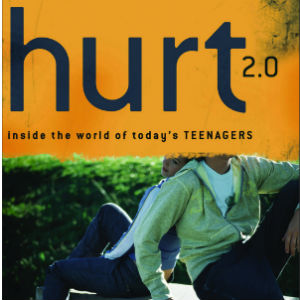 Hurt 2.0: Inside the World of Today’s Teenagers
Hurt 2.0: Inside the World of Today’s Teenagers Chap Clark
Baker Academic
264 pages
More than 55,000 readers of the first edition of Hurt (2004) discovered its revelations of disturbing trends in the hidden lives of America’s youth. Now Chap Clark – a professor of youth, family, and culture at Fuller Theological Seminary who is also editor of YouthWorker Journal – updates his Hurt Project research.
“From education to youth sports to media to parenting, just about every institution has become more complex, more demanding, and more relationally disengaged,” declares Clark. Teenagers’ underworld today, where they rely on groups of like-minded peers, is more entrenched and desperate.
Focusing on midadolescents from ages 15 through 18, Clark spent six months as a participant-observer at ethnically and economically diverse Crescenta Valley High School in Los Angeles County, Calif. As a substitute teacher, Clark told his students that he “was there to listen to them, to try to understand them, and to write a book for adults about what life is like for teenagers today.” The students let him in “to places that few adults are allowed,” Clark says in the first edition’s preface, reprinted alongside the new preface.
Witnessing students’ painful, hidden reality – which he dubbed “the world beneath” – Clark realized that this “uniquely vulnerable population” is reacting “to being set to sea rudderless, adrift without a compass.”
“The reason for Hurt 2.0 is that those who control and define the systems and structures charged with nurturing our young,” Clark states, “are either ignorant of how destructive life is for today’s adolescents or unwilling to take the wide array of indicators seriously.”
Keeping the original framework and updating the literature search, this new edition integrates recent data and trends, including increased rates of sexually transmitted diseases and self-injury, and the new concept of “multiple selves” in teens’ various relationships. It reveals the current teen landscape, from peers to family, sports, sex, and ethics, adding new chapters on social networking and marginalized youth.
Although Hurt’s first edition was embraced by adults who work directly with teenagers – educators, counselors, social workers, and youth ministers – the response of academics, administrators, and policymakers was lukewarm. Now “it is vital,” says Clark, “that the way our adolescents view and experience reality be brought to the forefront of the national conversation, especially in light of the vast chasm between their perspective and our cultural power systems.”
In today’s ethnically mixed society, Clark contends that adolescence is fundamentally different from the experience that adults recall. Researchers note rapid changes in cultural values, morality and ethics, gender, and family structure that have altered adolescence’s character and length. Technology does not appear in the researchers’ list of elements that have changed adolescence; Clark later covers online social networking – see p. 3.
Clark cites psychologist John Santrock, who says the period between childhood and adulthood now extends “from roughly 10-13 years of age” to “18-22 years of age.” In the 20th century, adolescence lasted three to five years. Now its main task – the search for identity and the building of responsible adulthood – can extend for up to 12 years. Some high school students find it difficult to focus on college and careers that seem so far away.
Through shifts in American society from the 1960s through the 1990s, Clark traces the unraveling of the stable adult community that cared for children’s needs, which has become “a free-for-all of independent and fragmented adults seeking their own survival.” Now adolescents feel abandoned. The “consequences of this trend,” says Clark, “are the basis of this book.”
Adults must recognize today’s altered adolescence. During encounters with students for this study, Clark realized that in his previous connections with teenagers, he had “failed to recognize that each young person exists in a social setting vastly different from my own.” Therefore, he had not “truly known” them, he writes. “I now believe this is true of every adult, including those who work with adolescents on a daily basis.”
Clark’s students reported exhausting dawn-to-midnight schedules of activities and studies “primarily concerned with adults’ agendas, needs, and dreams,” he writes. He encountered micromanaging parents who saw their taxi service to these activities as proof of their commitment to children whom they rarely see, even at meals. Having “forgotten how to be together,” we raise children in ways that are “subtle forms of parental abandonment,” he observes.
The result, revealed in one of many wrenching sidebar quotes from Clark’s young informants: “I could stare in the mirror for hours and find no connection between my thoughts and the face staring back at me. He seems more like a poorly casted actor whose eyes show disdain for his role.”
Midadolescents’ reaction to adult abandonment is to create “a safe place” that Clark calls “the world beneath.” This underground society has “its own rules of relating, moral code, and defensive strategies,” he says. In accordance with peer cluster theory, first described by Donald Posterski in 1985, teens band together in clusters with trusted friends who share their interests. Requiring complete loyalty in these makeshift families, teenagers “are reticent even to allow an adult to glimpse how badly they desire an adult who cares,” says Clark.
Many teenagers do feel cherished by their families. “Parents who lovingly seek to understand that their son or daughter is in the midst of wildly changing psychosocial experiences and events,” says Clark, “will be well on the way to being the kind of anchor the child needs.” Outside the family, adults must prove themselves trustworthy. Midadolescents believe that few adults care about them because we have “allowed a small group of teachers to belittle, authorities to ridicule, coaches to discourage, and parents to neglect and abuse,” he writes.
Hurt’s revelations about “radical changes in sexual attitudes and behavior” are likely to shock adults, particularly in regard to oral sex, matter-of-factly discussed by teen informants who often left Clark incredulous. He became convinced that sex is “a temporary salve for the pain and loneliness resulting from [society’s systemic] abandonment.” Clark counsels adults to “remind the young that love matters, that people are not objects or playthings, and that our bodies and our hearts cannot be separated.”
In the new “Partying, Gaming, and Social Networking” chapter, Clark’s informants confirm an inevitable part of midadolescent culture: the prevalence of risky behaviors involving alcohol, marijuana, and sexual experimentation. He warns adults that “the best way to cause a midadolescent to dive underground is to uncaringly disparage” this “community ritual.” A longing for community drives every adolescent behavior, including social networking – this century’s teen hangout is often virtual: texting, gaming, and Facebook.
The important new “Kids at the Margins” chapter examines teens in impoverished neighborhoods and elite private schools “at both ends of the sociological and developmental spectrum,” says Clark. How do “the vulnerable and the privileged” navigate the adolescent tasks of “identity, autonomy, and belonging?”
? Identity: Young people who are poor, homeless, disabled, racially oppressed, or otherwise marginalized, such as GLBT (gay, lesbian, bisexual, transgender), experience vulnerability that affects their sense of self. Privileged youth in wealthy families face high expectations from parents and peers; they must hide inner doubts. Clark shows that both privileged and vulnerable youth in our materialistic culture are defined by things they have or don’t have, not by who they are.
? Autonomy: In the “precarious journey” toward autonomy, says Clark, young people must believe in themselves in order to make good choices. Adults with an agenda undermine young people’s self-confidence and independence.
Marginalized youth have few mentors to help them explore their strengths. Wealthy parents can be so controlling that many privileged kids with whom Clark worked “were unaware of their inability to think critically on their own,” he says.
? Belonging: Clark was surprised to discover that privileged and vulnerable youth have more in common than we realize. Comfortable in their own neighborhoods, vulnerable youth often feel threatened in the outside world. Although privileged adolescents believe they’re at front-row center, belonging “is the greatest deficit privileged kids experience,” he says.
To counteract our society’s abandonment of its high school population, “the most significant help we can offer,” says Clark, “is to walk beside even one young person.” He concludes with suggestions for providing the necessities: nurturing organizations and programs, a stable and loving presence, and intimate relationships.
Hurt 2.0 is a revealing window into the hidden, often desperate reality of teenagers, who need caring adults in their lives more than ever. Immensely readable and rigorously researched, this report from the front lines engages youth advocates of all kinds. It remains a manifesto, calling for action and compassionate concern for youth in all walks of life.
Contact: (800) 877-2665, www.bakeracademic.com.
(NOTE: Clark’s related book, When Kids Hurt: Help for Adults Navigating the Adolescent Maze, was reviewed in the July/August 2009 issue of Youth Today; see www.youthtoday.org.)
Cathi Dunn MacRae, former editor of Voice of Youth Advocates (VOYA), specializes in teen writing and reading.































